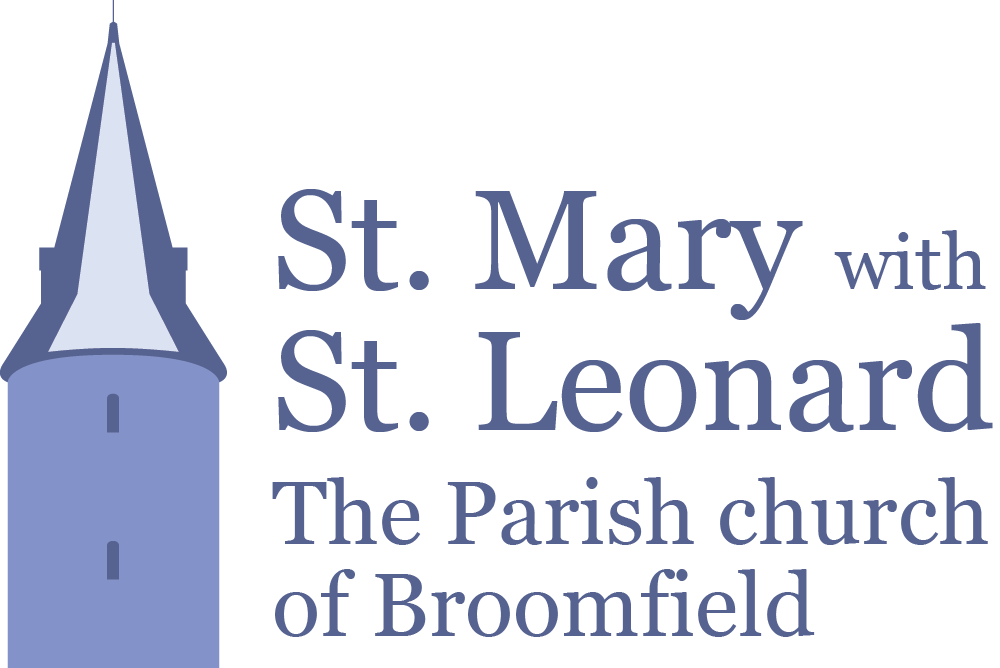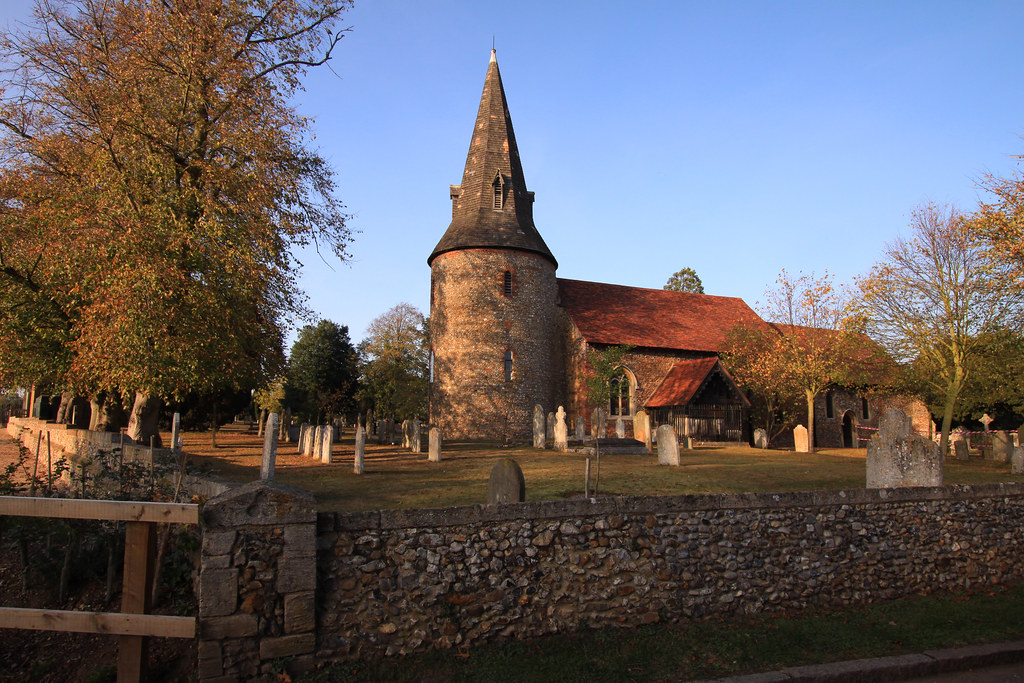Written by Anne Haward
Published October 2007; The Writer’s debt to the researches of Brian Kettle and Doug Shipman for previous Guides is gratefully acknowledged.
History
The original Norman church, possibly on the site of a wooden Saxon church was probably built on the initiative of the de Mandeville family of Broomfield Hall. almost a thousand years ago. The south wall of that original small church containing nave and chancel survives today. The windows were small lancets then and the chancel was shorter, as can be seen from the line of Roman bricks that formed the original south east corner. Among the flint and Roman bricks of the South wall is a projecting puddingstone, or mass of conglomerate. Some believe that such marker stones are an indication of a pre-Christian site.
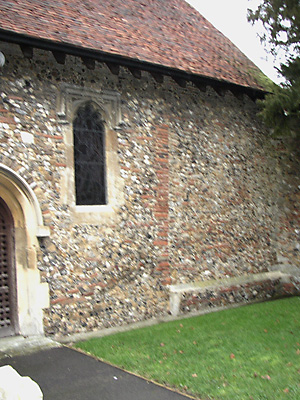
The Roman bricks are a reminder of the story still related fifty years ago. The plan had originally been to build the church at the top of New Barn Lane. However every night a dragon moved the stones down to the Green. Finally the villagers gave up and built the church where it is today. In the field at the end of New Barn Lane, called Dragon’s Foot in the tithe maps, there is a depression, now somewhat ploughed out but still deep enough to be a dragon’s footprint. This was the site of a Roman building which still yields numerous hypocaust tiles and bricks, so the story is a delightfully muddled memory of the Saxons trundling cartloads of Roman bricks down to the Green on the orders of their new Norman masters to use for the quoins, since there were no local stone quarries.
The lack of cut stone is also the reason for the round tower. The thickness of the wall at the tower arch which is virtually that of the church west wall and the tower wall together shows that this was added later, possibly about 1130. The circular structure of courses of flints was built against the west wall, growing at roughly nine courses a year and built of rubble and field stones. Elsewhere round towers fell out of fashion and so were gradually replace as transporting stone became easier and more affordable, but Broomfield is proud to be one of the six that survive in Essex.
This first church was dedicated to St Leonard and around 1150 the church and tithes of Broomfield were given to the Prior and canons of Holy Trinity, London. This foundation appointed the vicars for Broomfield until the Reformation.
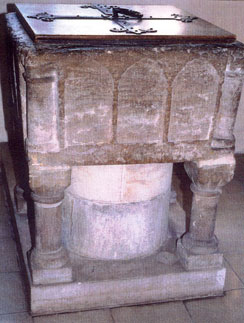
Early in this period the Norman font of Barnack Stone was given to the church. The arcaded sides and four pillars are typical of the period but the central support is a later addition. Solid though it looks the font has been moved several times, and not only in recent re-orderings. During the Civil War the font was thrown out of the church along with stained glass and candlesticks as a sign of ‘popery’. The story goes that Cromwell’s soldiers used it as a trough to water their horses. Certainly it re-appeared in the Vicarage stableyard where it was later recognised and restored to the church.
During the 14th and 15th centuries larger windows were introduced in the south wall. The earliest was the low-side window near the pulpit, As well as gaining larger windows at this time the church had its chancel extended in 1430 and the perpendicular style east window installed. The line of Roman bricks in the south wall clearly marks where the old chancel ended. Other changes included the spire, with its remarkable internal timber frame dated to 1460-70, added to the tower. The first south porch was built and to the right of the south door was a holy water stoup, since vandalised by the Commonwealth iconoclasts. By 1504 the church had been re-dedicated to St Mary. There was no north aisle but some form of chapel to St Leonard still existed on the north side, as we know that Broomfield had a chantry priest. In the early 1500s he was making up the sums he was paid to say masses for the souls of the departed by teaching children at Writtle.
When in 1541 Henry VIII dissolved the Priory of the Holy Trinity, the Priory’s possessions were bought by Lord Rich of Leez, who used the Broomfield tithes to help fund his new school at Felsted. Protestant enthusiasm removed the signs of ‘Popery’ but with the re-introduction of Catholicism under Mary Tudor, the churchwardens at Broomfield had to buy a mass book, a cross and images for the rood screen. Under Elizabeth I, the Act of Uniformity brought the end of the chantry chapel, and the introduction of parish registers. The first page of our earliest register – now in the Record Office – is decorated with cadells and swashing and reads:
‘The Register Booke for the Parish of Bromefeild in the Countie of Essex in which is contained all the Baptisms, Burialls and Marriages which could be found from the year of our Lord 1546 untill the year 1598 and the 27th daie of Maie & deinceps (i.e.from then on).’
A visitation of 1689 gives a depressing picture of what the church was like after the turbulent years of the Commonwealth. The smashed stoup in the Porch is a lasting reminder of the dissenters. Thomas Woollard, church-warden and founder of the Broomfield Woollard Charity, and the new Vicar, Revd. Thomas Cox, the scholar and historian, listed what the church possessed (two items) and what was needed (seventeen). Besides repairs to the uneven floors, cracked walls, missing glass and clearing the rubbish from the church-yard, at this time a gallery was added at the west end. After 46 years Cox was succeeded by another historian, Philip Morant. He is the first to mention a little vestry at the north-west corner of the church.
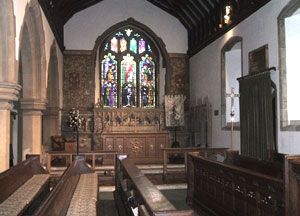
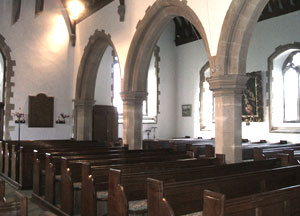
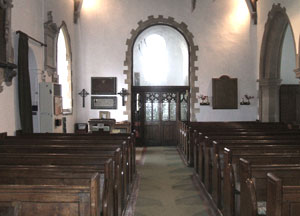
By 1870 the small brick built north aisle that had been added in the early 19th c. was both inadequate and unsound and a major restoration was begun. Over the next few years the church took on the general appearance that it has today. Frederic Chancellor, Mayor of Chelmsford as well as being Diocesan Architect, drew up elaborate plans for Broomfield church which are preserved in the Essex Record Office. To him we owe the stone pillared arcade and north aisle, built in materials to match the rest of the church, the vestry, the replacement of box pews with the present benches, and the choir stalls. He also added a barrel organ and gallery, which were later removed. The north east corner, now occupied by the Lady Chapel, was originally filled with benches and these were the seats favoured by the families from the ‘big houses’. The rest of the congregation dubbed this area, fronted by its stone communion rail, “the Drawing Room”. Chancellor’s plans included large wall paintings, but only the Commandment boards and the painted East wall of the Chancel were adopted. The generosity and efforts of Henry Wells, a local brewer and Church warden for 44 years made the work possible. Frederic Nield, miller and flour merchant, donated the Gothic carved credence and sedilia on the south wall of the chancel. These and the stone reredos depicting the Last Supper was carved by Ray and Fuller of Chelmsford and are a modified version of Chancellor’s more elaborate designs. The lych gate and present porch also date from this time.
In 1926 the William Hills organ was given by Richard Clay of Little Orchards in memory of his parents. The church suffered bomb damage to the north wall, roof and windows in 1943, which is recorded in the painting by Rosemary Rutherford in the north aisle. The second half of the century saw the installation of a new altar, communion benches and lectern and the on-going provision of cheerful hand-embroidered kneelers.
By the end of the 20th century the original church hall, which stood on the far side of the busy main road had proved to be too outdated and inconvenient. The decision was taken to build a new extension, linked to the church. Funded by a grant from the Fowler Trust, the sale of the site of the old hall and untiring money raising efforts and donations on the part of the congregation, the new building was finally dedicated in 1997. Designed by Tim Venn it provides a hall, a committee room, kitchen and toilets and makes imaginative re-use of the windows removed to provide access from the church. Now known as St Leonard’s Hall, it has proved a valuable addition for the work of the church.
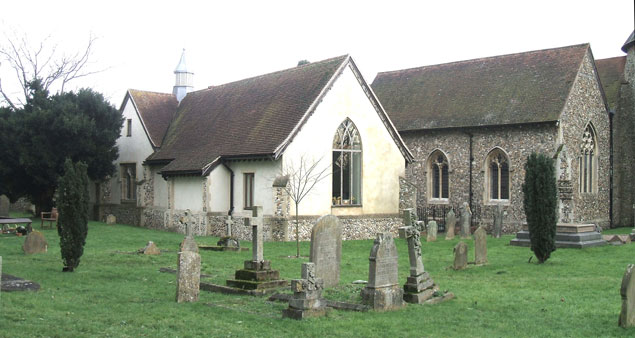
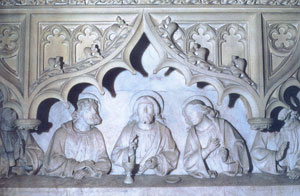
Exploring the Church
The Chancel
It is apparent that the Chancel is askew and the E. window not centrally sited, but no convincing reason why has as yet been given. The Caen stone reredos and carving of the Last Supper, as well as the credence in the form of a piscina in range with a sedilia, or server’s seat, date from 1893 and were adapted from Chancellor’s drawings by Ray and Fuller of Chelmsford. The choir stalls, like the pulpit, are decorated with bosses patterned with local flowers and leaves, buttercups, oak, ivy, etc. The altar and communion benches were the gift of the congregation in 1959.
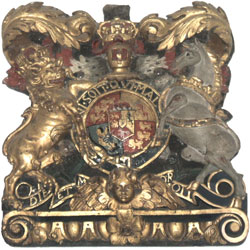
The Nave and North Aisle
The pulpit, benches and tower screen date from the 1870s restoration. On the South wall is a large stone tablet giving not only the names of Broomfield incumbents from 1230 to the present day, but the patrons of the living. Above the South door are the Royal Arms of George III, carved in sycamore and dating from the early 19th c. These were restored in 1959 thanks to the local British Legion. The glass screen above the tower arch, a welcome draught excluder, was the gift of a former churchwarden, Arnold Young in 1959.
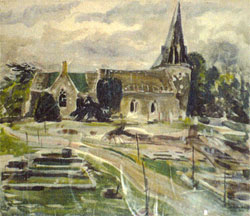
Two large oil paintings hang in the North Aisle; a copy of the Madonna of the Veil by Carlo Dolci and a copy of Andrea del Sarto’s Virgin and Child with St Elizabeth and St John the Baptist The latter was donated by Constance Nash of Broomfield Court, which is now the site of Broomfield Hospital. Hanging nearby is Rutherford’s watercolour of the church covered in tarpaulins after the 1943 bombing.
The Tower
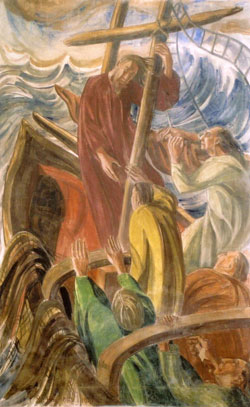
In the tower is the only true fresco in an English church. Christ stilling the Storm was painted Rosemary Rutherford, artist daughter of the then Vicar, in 1941 when on leave from war service. Her brother helped mix the fresh plaster and traditional techniques were followed as far as possible. The fresco was restored in 2023 and the tower is now a space for meditation, open during Church Open times or on request.
There is a record of bells from as early as 1482, but the present peal of six is made up of four bells presented by H.C.Wells in 1912 and two that were re-cast at the same time, John Dier’s bell of 1580 and that of Miles Graye, 1613. The bells are still rung regularly.
The Story of the Bells
Memorials
The striking memorial, on the east of the South door, is to Thomas Manwood who lived at Priors. The Latin lists his distinguished forbears and his daughters and only son, Thomas, who dedicated the monument. Thomas died without issue and is commemorated in the memorial to the west of the door erected by his nephew, Thomas Pocklington, the Manwood heir. There are two War Memorials, that on the West wall commemorates the dead of the 1914-18 war, while the 1939-45 Memorial is incorporated in the sill of the War Memorial window. The two iron World War I grave markers are unusual. They commemorate two sons of the Nash family, whose father Col. Nash, was given them by Kitchener, his Sandhurst friend.
The most interesting memorials are unfortunately out of sight. Beneath the carpet are two ledger slabs, now detectable only by the bumps in the carpet that indicate their carved achievements of arms. At the entrance to the Chancel is the slab to John Sewell, d. 1719, who was Page of the Backstairs to William III, ‘who died (addd text) in his arms’ in 1702. John Sewell is recorded as living at the Parsonage from 1708-18. The second slab is to Rev. John Gibson; a former fellow of All Souls, Oxford, who died in 1756 at the age of 37. Now mounted on the wall, but obscured by a cupboard, is Broomfield’s only brass; it is to Thomas Huntleye and his wife, Rachell. All the brass figures are missing, except for the small kneeling figure of his daughter, Ann, and two inscription panels.
RELLIGIO TIBI SACRA FVIT MORES BENE CVLTI, FŒLIX DISCESSVS : GLORIA FINIS ERIT GODLY WAS HIS PROFESSION RELIGIOUS WAS HIS CONVERSATION BLESSED WAS HIS DISSOLVTION. GLORIOVS SHALL BE HIS RESVRRECTION. HERE LYETH EXPECTING A IOYFULL RESVRRECTION, THE BODIE OF MR THOMAS HUNTLEYE, LATE CITTIZEN AND MARCHANT ADVENTVRER OF LONDON WHO MARRIED RACHELL THE DAVGHTER OF MR IOHN PAKE OF THIS TOWNE GENTLEMAN. WHO HAD ISSVE BY HER TWO CHILDREN, WILLIAM AND ANN WHO DEPARTED THIS LIFE IN THE LORD THE 24TH DAY OF APRILL 1613
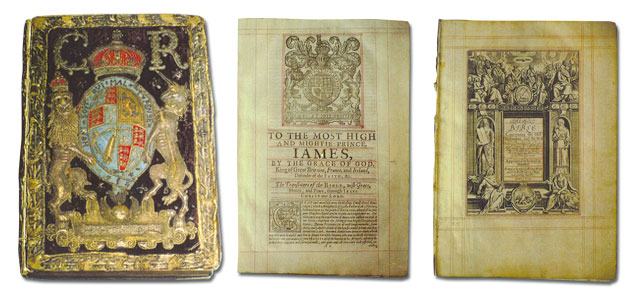
Partly hidden by the altar is the tomb slab of Patrick Younge, librarian to Charles I. During the Commonwealth he came to live in Broomfield, bringing with him the King’s last gift to him – his own Bible. This handsome book, bound in crimson velvet heavily embroidered with the Royal Arms in silver and gold thread, he left to his granddaughter Sara Attwood, who in turn left it to St Mary’s. In the 19th c. the Bible in a brown paper cover was almost sold in the auction of Rev. Vincent Edward’s effects. Luckily it was rescued by a Colonel Lucas who felt the rich raised binding beneath. Once it lived in the handsome case to the north of the Chancel arch, carved with the words of Sara’s presentation. Today for reasons of security and conservation it is kept in the Essex Record Office.
The Windows
Many of the windows were damaged during World War II and no record remains of the windows installed at the time of the 1870s restoration. As Rosemary Rutherford went on to become a stained glass artist, whose work is becoming increasingly recognised, we are fortunate in having four of her windows. The 15th c. perpendicular East window depicts the Resurrection, with the sorrowing women and disciples in the lower part of the lights, and in the upper joyfully recognising the Risen Lord. The glass in the three single light windows in the south wall commemorate members of the Rutherford family and dates from the mid 20th c. From east to west they portray the Raising of Lazarus, Christ and the Woman of Samaria and Christ washing the Disciples’ feet. The centre window is in paler tones, as Rutherford’s strong dark colours had led to complaints that the Chancel was becoming too dark. In all four of her windows the head of Christ seems to be derived from the austere features of her father.
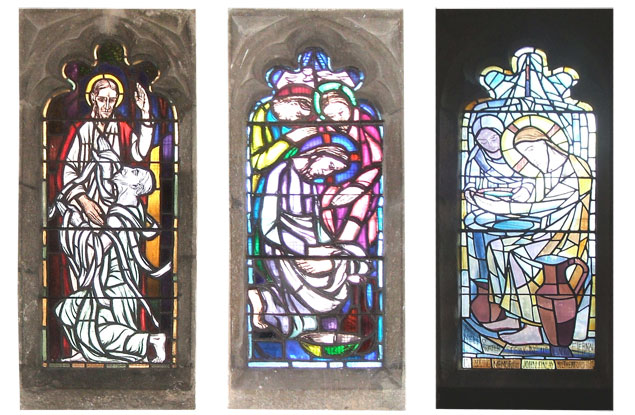
In the Nave the 14th c. low side transom window shows our two patrons, St Mary in the upper light and St Leonard in the lower. This and the War Memorial Window of St Michael and St George, with its vivid contemporary detail of servicemen, are by Whitefriars. The colourful Epiphany window at the east end of the North Aisle is by G.E.R.Smith.
No church with an active congregation stands still. By the time of your visit to the church, there will have been changes and additions. However the Gospel proclaimed and the welcome offered remain unchanged.
